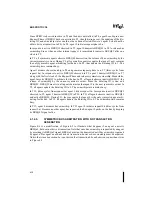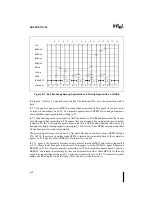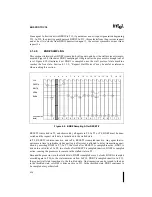
4-23
BUS PROTOCOL
In T1, there are no transactions outstanding on the bus and {scnt} is 0. In T2, transaction 1 is
issued. In T4, as a result of the transaction driven in T2, {scnt} is incremented.
In T5, transaction 2 is issued. In T6, which is four clocks after the corresponding ADS# in T2,
the snoop results for transaction 1 are driven. In T7, {scnt} is incremented indicating that there
are two transactions on the bus that have not completed the Snoop Phase. Also in T7, the snoop
results for transaction 1 are observed. As a result, in T8, {scnt} is decremented.
In T8, the third transaction is issued. Two clocks later in T10, {scnt} is incremented. In T11,
{scnt} is decremented because the snoop results from transaction 2 are observed in T10.
In T13, the snoop results for transaction 3 are observed and in T14 {scnt} is again decremented.
4.4.2.2.
STALLED SNOOP PHASE
Figure 4-13 illustrates how a slower snooping agent can delay the Snoop Phase if it is unable to
deliver valid snoop results within four clocks after ADS# is asserted. The figure also illustrates
that the snoop phase of subsequent trasactions are also stalled and occur two clocks late due to
the stall of transaction one’s snoop phase.
Transactions 1, 2 and 3 are initiated with ADS# activation in T2, T5, and T8.
The Snoop Phase for transaction 1 begins in T6 four clocks from ADS#. All agents capable of
driving valid snoop response in four clocks drive appropriate levels on the snoop signals HIT#,
HITM#, and DEFER#. A slower agent that is unable to generate a snoop response in four clocks
asserts both HIT# and HITM# together in T6 to extend the Snoop Phase. Note that if the Snoop
Figure 4-13. Snoop Phase Stall Due to a Slower Agent
CLK
ADS#
{REQUEST}
HITM#
AERR#
HIT#
A
AA
AAAAAA
AA
A
AAAAAA
A
A
AAA
AA
A
AAAA
A
A
AAA
A
A
AAAAAA
1
1
2
3
4
5
6
7
8
9
10
11
12
13
14
15
16
AA
AA
AAAAAA
A
A
AAAAAA
A
A
AAAAAA
AA
AA
AAAAAA
2
3
AA
A
AAAA
1
2
2
3
AA
A
AAAA
A
A
AAA
DEFER#
1
3
1
1
2
2
3
3
0
0
0
1
1
1
2
2
2
2
2
2
1
1
1
0
{scnt}
Summary of Contents for Pentium Pro Family
Page 17: ...1 Component Introduction ...
Page 26: ...2 Pentium Pro Processor Architecture Overview ...
Page 27: ......
Page 36: ...3 Bus Overview ...
Page 62: ...4 Bus Protocol ...
Page 105: ...5 Bus Transactions and Operations ...
Page 126: ...6 Range Registers ...
Page 131: ...7 Cache Protocol ...
Page 135: ...8 Data Integrity ...
Page 148: ...9 Configuration ...
Page 161: ...10 Pentium Pro Processor Test Access Port TAP ...
Page 172: ...11 Electrical Specifications ...
Page 201: ...12 GTL Interface Specification ...
Page 229: ...13 3 3V Tolerant Signal Quality Specifications ...
Page 233: ...14 Thermal Specifications ...
Page 239: ...15 Mechanical Specifications ...
Page 241: ...15 2 MECHANICAL SPECIFICATIONS s Figure 15 1 Package Dimensions Bottom View ...
Page 252: ...16 Tools ...
Page 260: ...16 8 TOOLS Figure 16 4 Generic MP System Layout for Debug Port Connection ...
Page 264: ...17 OverDrive Processor Socket Specification ...
Page 290: ...A Signals Reference ...
Page 320: ...Index ...
Page 328: ......
















































